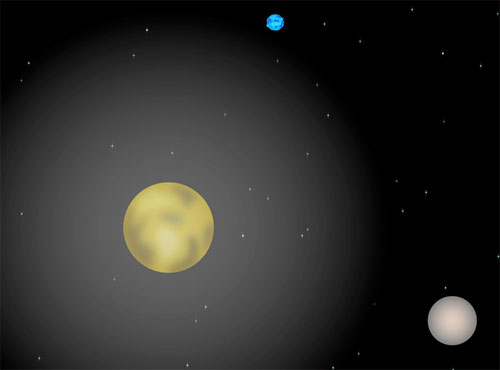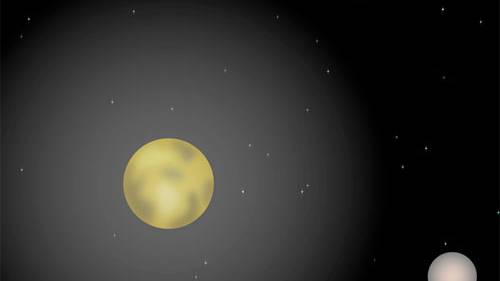Pluto’s Expanding Atmosphere Confounds Researchers
Source: news.sciencemag.org
Recent observations of Pluto reveal that the icy orb’s atmosphere has expanded dramatically since 2000, and for the first time researchers have detected carbon monoxide. The findings may be evidence of seasonal changes in climate linked to Pluto’s most recent close approach to the sun, but scientists still aren’t sure about how those variations unfold over the course of each 248-year orbit.
Pluto’s atmosphere recently expanded dramatically and now extends almost one-quarter of the distance to Charon, its largest orbital companion (lower right).
Credit: P. A. S. Cruickshank
Pluto is the only object orbiting in the frigid realm beyond Neptune that is known to have an atmosphere. That tenuous sheath of gas was discovered in 1988 when the “dwarf planet” passed between Earth and a distant star, blocking some of the star’s light. Although telescopic observations at various wavelengths since the early 1990s have since identified several substances in Pluto’s surface ices—including nitrogen, methane, and carbon monoxide—only methane had been detected previously in its atmosphere.
Now scientists can add carbon monoxide to the mix. New observations of the atmosphere’s emissions at various wavelengths, particularly at the 1.3-millimeter wavelength, betray the presence of the gas for the first time. Because carbon monoxide probably could have been observed by instruments in previous studies, its newfound presence likely marks a new stage in the season-by-season evolution of Pluto’s atmosphere, the researchers suggest. Pluto was discovered only about 80 years ago—less than one-third of the time it takes to make a single orbit, notes team member Jane Greaves, an astrobiologist at the University of St. Andrews in the United Kingdom, so “we’re seeing everything happen for the first time.”

Pluto rendered surface (ESO/L Cal ada)
Although methane and carbon monoxide are the only gases yet detected in Pluto’s atmosphere, scientists expect that by far the largest constituent is nitrogen, a gas that’s hard to detect due to its subdued emissions characteristics at many wavelengths, Greaves says. “It’s frustrating that we don’t know about 97% of Pluto’s atmosphere.”
The new observations also reveal that Pluto’s atmosphere is growing. Data collected around the turn of the century suggested that Pluto’s cold, diffuse atmosphere extended no more than 135 kilometers above the planet’s surface, Greaves says. But she sees hints of an atmospheric expansion in data that she and her colleagues gathered using telescopes atop Hawaii’s Mauna Kea on 11 nights scattered between August 2009 and May 2010. She says that the atmosphere now reaches heights of more than 3000 kilometers—a distance almost one-quarter of the way to Charon, Pluto’s largest moon. “This is not what we expected,” Greaves says. “The atmosphere has changed so dramatically.”
Pluto travels along a highly elliptical path and last passed closest to the sun in 1989. Many planetary scientists expected the atmosphere to shrink as the icy orb began receding from the sun’s warmth. The unanticipated expansion may be related to changes in the darkness of the orb’s surface a decade or so ago, which may have caused the surface ices to absorb more solar radiation and more efficiently evaporate. Or, Greaves suggests, long-term variations in the sun’s ultraviolet output, changes linked to the roughly 11-year cycle of solar activity, may be playing a role. The team will present both findings tomorrow at a meeting of the Royal Astronomical Society in Llandudno in the United Kingdom.
The recent changes in the atmosphere, as well as their timing, are indeed unexpected, says Peter Barnes, an astronomer at the University of Florida, Gainesville. “Pluto is obviously a much more dynamic object than anyone had expected.”
Current studies are just a taste of what’s to come when NASA’s New Horizons mission nears Pluto. The heavily instrumented craft, launched in 2006, is halfway to Pluto and should whiz by the icy orb and its orbital companions in 2015.
Article from: news.sciencemag.org
Front Page Image: NASA
Also tune into:
Wallace Thornhill - The Electric Universe
Donald E. Scott - The Electric Sky
Rens van der Sluijs - Plasma Mythology & The Axis Mundi
Susan Joy Rennison - Cosmic Origins of Global Warming
Joseph P Farrell - Cosmic War, Interplanetary Warfare & Mesopotamian Mythology
Andy Lloyd - Dark Star, Evidence for Planet X
Craig Hines - Gateway of the Gods
Andrew Johnson - Chemtrails, Weather Modification & Climate Change
Robert Felix - The Coming Ice Age
Tim Ball - Climategate & The Anthropogenic Global Warming Fraud
James Follett - The Church of Global Warming
Susan Joy Rennison - A New Cosmic Age, Space Weather & Cosmic Radiation






















